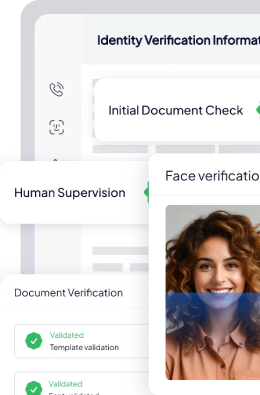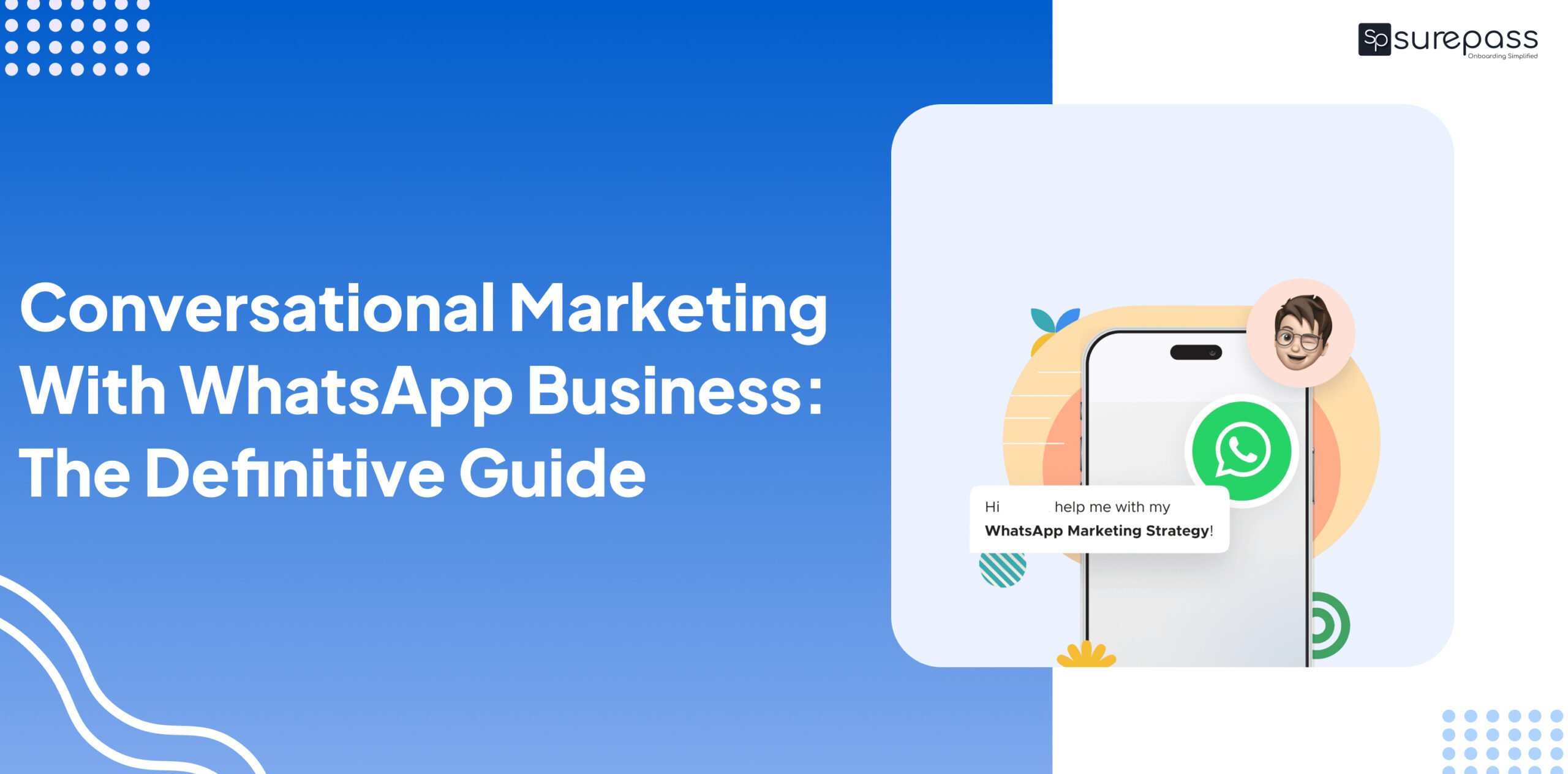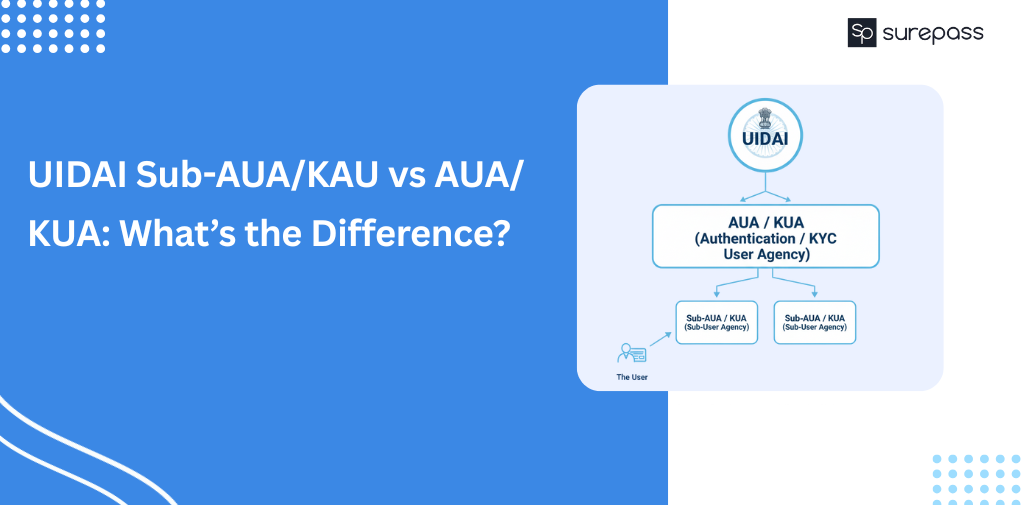Though it is still relatively new, conversational marketing has risen to the top of many brands’ marketing strategies. What makes it tick, and how can you use it in your WhatsApp conversations with buyers? Here’s everything you need to know about WhatsApp business conversational marketing.
If you’ve been following the Surepass blog, you’ll know that we provided a brief definition of conversational marketing in an earlier post.
This guide will delve even deeper into what conversational marketing is, its characteristics, and what makes it so effective.
We’ll use conversational marketing in chatbots and messenger apps, particularly WhatsApp.
Why is WhatsApp used? That’s because (as you’ve probably guessed if you’ve been reading our blog), it’s the world’s most popular messaging app, with over two billion users worldwide.
That means there’s a lot of room for engagement, sales, and business growth.
This guide will be divided into sections, so feel free to skip ahead to the section(s) that interest you. This post’s content is broken down as follows:
- What exactly is conversational marketing?
- Conversational marketing’s main characteristics
- Statistics on conversational marketing
- Conversational marketing examples
We have a lot to unpack here, so let’s not waste any time and get right to work.
What is Conversational Marketing?
Let’s go back in time and examine the origins of conversational marketing.
Conversational marketing has been around for much longer than most people realize. The personalized exchange of dialogue occurs when a company interacts with its target audience.
Conversational Marketing Definition
Conversational marketing, also known as one-to-one marketing, is a one-to-one marketing strategy used by businesses to shorten the sales cycle, learn more about their customers, and create a more human buying experience.
From this, we can see that a buyer-salesperson interaction during an in-store shopping experience, or even a phone conversation before eCommerce, would qualify as conversational marketing.
Conversational marketing has thus existed since the dawn of time.
What’s more, guess what? It very well could have been; the term was never coined.
However, it is worth noting that the term “conversational marketing” did not become more widespread until chatbots and messaging apps were introduced as brand communication tools.
It is now what most people think of when they hear the term.
The Main Characteristics of Conversational Marketing
Conversational marketing is fundamentally about creating and engaging in dialogue with people who are potentially interested in your product. Face-to-face interactions, video/voice calls, social media engagement, and even email marketing are examples.
But what exactly qualifies as a conversational marketing exchange?
It is no surprise that all of its characteristics are linked to its root word: “conversation.”
Here are some of the critical features of conversational marketing:
It happens in real time. Like most conversations we have with our friends and family, Conversation marketing takes place in real time. This ensures that all parties are engaged and paying attention.
This is why it works so well on WhatsApp, a chat app designed for quick exchanges and to bring people closer together.
- It is customer-focused. Customer-driven conversational marketing: As a business, you should provide personalized engagement
with your buyers – as if you were only communicating with them. This meaningful and personal touch and care (more on how to
share this in the following section) builds trust and encourages customers to continue the conversation. - It’s entirely natural. One of the primary reasons why most brands prefer chatbots and messaging apps for conversational
marketing is that their nature allows dialogues to flow and develop naturally and comfortably. Informal marketing exchanges
should never feel like they are between two strangers. - It’s not a one-way street. Conversational marketing, unlike other forms of marketing such as paid advertisements, is bi-
directional. It allows all parties involved to raise their voices whenever they want. When you chat with a customer,
you’re also giving them the option to lead and take charge of the conversation.
Conversational Marketing Statistics You Should Be Aware Of
We provided a few conversational marketing statistics in our previous post to highlight its effectiveness. If you’re still not convinced, here are a few more examples.
Customers expect Real-Time Chats
According to a recent survey, 71% of customers expect businesses to chat with them in real time.
This statistic emphasizes the significance of conversational marketing, which allows for crystal clear and real-time communication with customers when implemented via chat apps.
This allows them to ask questions whenever they need to, which increases engagement, but it also indirectly improves the overall customer experience and satisfaction.
Increased Recurring Purchases due to Live Chat Support
Customers are more likely to buy from a company that provides live chat support, according to 51% of them.
This can range from interacting with automated chatbots programmed to answer frequently asked questions to chat with a human agent.
Do you want more specific figures? Sixty-three percent of buyers with an online spending profile of $250 to $500 are more likely to purchase from and remain loyal to live chat support businesses.
If your target buyers fall into this price range, you should consider developing a WhatsApp chatbot for your business if you don’t already have one.
Customers are content with using Messaging Apps to contact Customer Service Teams
When it comes to contacting a company’s customer service team, nearly eight out of ten (79%) consumers are willing to do so through messaging apps.
This is one of the essential conversational marketing statistics for several reasons.
It demonstrates consumers’ growing preference for direct communication, as older forms such as email forms become less popular. Furthermore, it emphasizes consumers’ desire for immediate problem resolution rather than having to wait for a response from the company.
Similarly, failing to provide messaging options would mean passing up a huge opportunity to meet modern consumers’ expectations.
Every day, 175 million WhatsApp Messages are sent to Business Accounts
Last but not least, this conversational marketing statistic should pique your interest in starting with WhatsApp Business.
According to Meta (WhatsApp’s parent company), every day, up to 175 million WhatsApp messages are sent to business accounts, according to Meta (WhatsApp’s parent company). Please remember that this statistic is from October 2020, only two years after WhatsApp Business was launched.
This is a highly rapid adoption, demonstrating the popularity of brand conversational marketing and its positive effects on consumers.
As WhatsApp introduces new features to improve communication, there’s no doubt that more and more people worldwide will begin to message their favorite brands on WhatsApp.
Conversational Marketing: A Guide to Success
Now that we’ve defined conversational marketing and provided statistics to back it up let’s look at how you can best implement it on WhatsApp Business.
Keep it Simple
Nothing turns off customers like big words, long sentences, and massive walls of text.
Keep in mind that conversational marketing aims to keep your customer engaged. To accomplish this, keep your conversations with them as simple as possible.
Avoid using long sentences in your WhatsApp conversations with customers, and never spam them. Both of these can lead to misunderstandings, animosity, and the loss of a customer.
Make the most of WhatsApp’s Features
There are numerous features on WhatsApp that you can incorporate into your conversational marketing strategy, ranging from interactive messages in WhatsApp Business to multimedia tools.
Calls-to-action and quick reply buttons, for example, encourage engagement by providing convenient and straightforward messaging options (which are only available to WhatsApp Business API users).
The ability to attach media files to your WhatsApp conversations with buyers also aids in keeping the conversation lively and entertaining.
Use Emojis
There’s no denying that emojis are an integral part of WhatsApp conversations. The use of emojis has increased over the last decade and is now high.
The informal nature of conversational marketing allows brands to use emojis with buyers on WhatsApp.
Even though this may appear to be a minor and insignificant tactic, it is a very effective (and not to mention simple) way to stimulate engagement because it keeps the conversation informal and fun.
Greet your Customers using their Names
You want to put your customers at ease when using conversational marketing. So, when addressing them on WhatsApp, use their first names.
Calling them “sir” or “madam” or even using salutations immediately elevates the conversation and creates an invisible barrier between you and your buyer.
As a bonus, it demonstrates your brand’s confidence and comfort.
Similarly, you might consider giving your chatbot a name to make the exchange more personal. If human agents handle your incoming WhatsApp messages, they may introduce themselves using their actual (or fictitious) names.
Conversational Marketing Examples
Let’s look at some of the best examples of conversational marketing from well-known brands.
Even if some of them aren’t done through WhatsApp Business, they’re still excellent sources of inspiration and can be easily incorporated into your WhatsApp conversational marketing strategy.
Domino’s
Remember when ordering pizza meant picking up the phone and dialing? It’s a hazy memory for us as well.
Thanks to chatbots, consumers can now get pizza delivered after a few quick message exchanges.
With conversational marketing, Domino’s Pizza simplifies the pizza ordering process. Aside from the casual and informal tone, the brand employs various interactive message templates such as quick replies to expedite orders and provide a more pleasant (and visual) user experience.
ADAC’s Don’t Call Mom
For example, we are staying in Germany. This time, it’s Europe’s largest motoring association, ADAC’s “Don’t Call Mom” WhatsApp campaign.
The goal of this campaign, which was launched in 2018, was to help ADAC connect with the younger generation who did not (yet) own a car. (Way to think ahead, ADAC!)
To accomplish this, they launched an entirely conversational marketing campaign. Participants were encouraged to ask the ADAC team any questions, especially those they would never ask their parents.
Behind those responses was an ADAC community team that answered every single question directly in a one-on-one private chat.
The result? ADAC has gained thousands of shares and approximately 20 million new contacts. It was, without a doubt, a rousing success.
&nbsap;
WhatsApp Business Conversational Marketing
With everything said and done in this guide, the advantages of conversational marketing with WhatsApp Business for a business could not be more apparent.
Even though it is a strategy that can be implemented and executed using the free WhatsApp Business app, the API provides so many more options that it would be a shame not to give it a shot.
For example, using the API, you can create more personalized exchanges with your buyers, a crucial feature of conversational marketing. These interactions can also be analyzed and used to improve your communication.
If you’re serious about your company’s conversational marketing on WhatsApp, the first step is to create a WhatsApp Business API account.
Surepass is an official WhatsApp Business Service Provider (BSP) and would be delighted to assist you in getting started. Contact us, and a member of our team will contact you.





